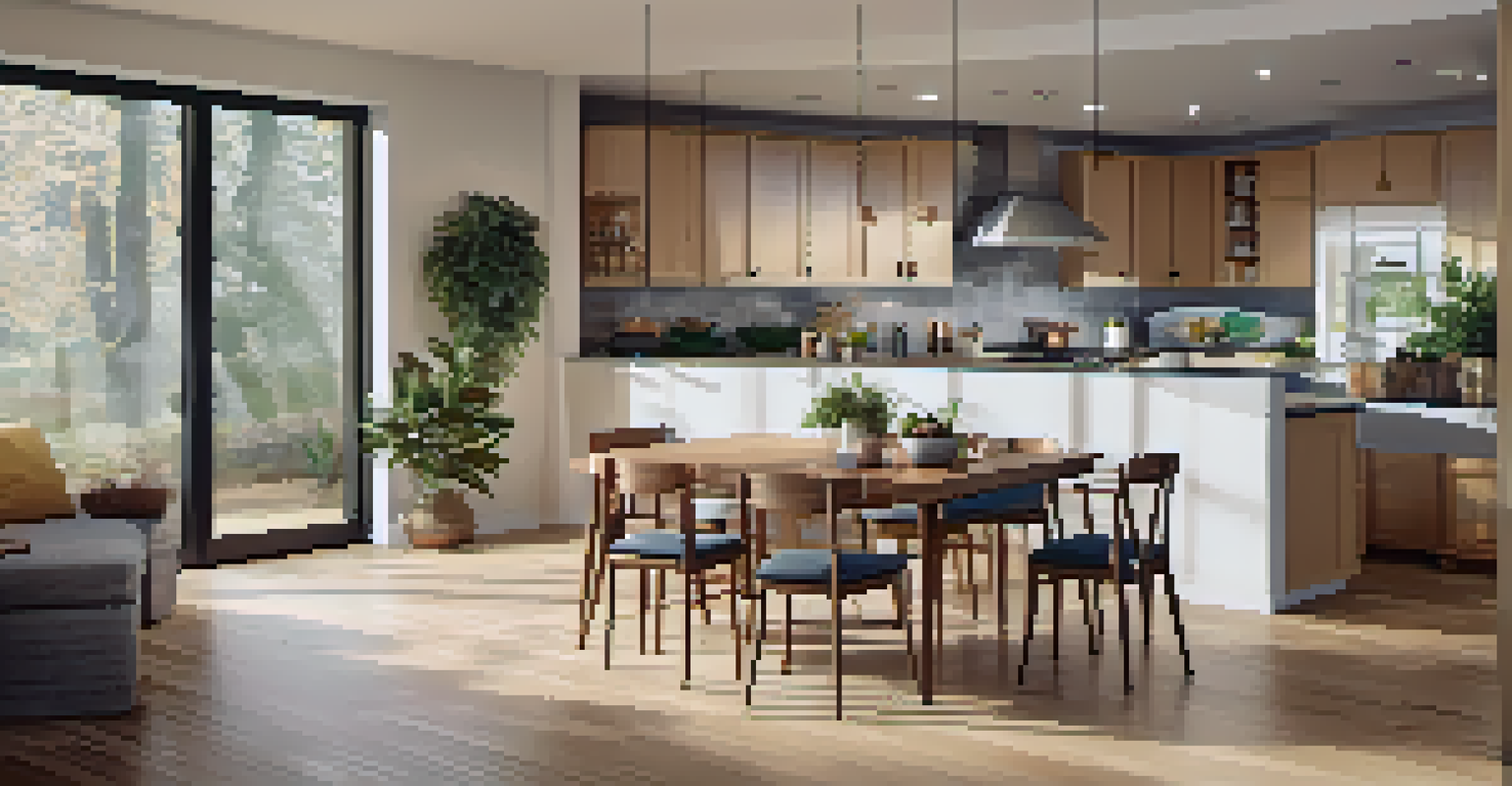Designing Accessible Multi-Story Homes for Everyone

Understanding Accessibility in Multi-Story Homes
Accessibility in multi-story homes means creating spaces that everyone can use comfortably, regardless of physical ability. It goes beyond just adding ramps; it involves thoughtful planning to ensure that all aspects of the home are navigable. Whether it’s for seniors, individuals with disabilities, or families with young children, accessibility should be a priority for every home design.
Accessibility allows us to tap into our greatest potential, and creates a better world for everyone.
For instance, consider the layout of stairs, door widths, and hallways. A well-designed home allows for easy movement, ensuring that everyone can access every part of the house without obstacles. This understanding is crucial for architects and homeowners alike, as it lays the groundwork for an inclusive living environment.
Moreover, creating an accessible home isn’t just about compliance with regulations; it's about fostering a sense of belonging for all. When homes are designed with accessibility in mind, they not only meet legal standards but also enhance the quality of life for residents and visitors.
Key Features for Accessibility in Design
When designing accessible multi-story homes, certain features stand out as essential. Wide doorways, lever-style handles, and accessible switches can make a significant difference. Additionally, incorporating features such as non-slip flooring and adjustable shelving can enhance functionality and safety for everyone.

Another important consideration is the placement of bathrooms and bedrooms. Ideally, these spaces should be located on the same floor to minimize the need for stairs. If that’s not possible, installing a stair lift or an elevator can provide an effective solution, ensuring that all residents can move throughout the home comfortably.
Accessibility Enhances Comfort
Designing multi-story homes with accessibility in mind ensures that all residents, regardless of their physical abilities, can navigate and enjoy their living spaces.
Furthermore, think about the outdoor spaces as well. Ramps leading to porches or gardens can create a seamless experience for residents while also making it easier for guests to visit. Ultimately, these thoughtful features create a welcoming environment for everyone.
Choosing the Right Materials for Accessibility
The materials used in building accessible homes play a crucial role in their functionality and safety. For example, selecting flooring that is both slip-resistant and easy to clean can greatly enhance safety for individuals with mobility issues. Similarly, materials that provide good grip on railings and stairs can prevent accidents and provide reassurance.
Designing for accessibility is not just about compliance; it’s about ensuring everyone can navigate and enjoy their spaces.
Additionally, consider the durability of materials. Choosing long-lasting options means fewer replacements and repairs, which is especially beneficial for families with varying needs over time. This is an investment in the future, ensuring that the home remains accommodating for everyone as their circumstances change.
Moreover, it's essential to consider the aesthetic appeal of these materials. Accessible design doesn’t have to sacrifice beauty for functionality; with the right choices, homes can be both stylish and practical. This balance can help dispel the misconception that accessible homes are less attractive.
The Importance of Smart Home Technology
Incorporating smart home technology can significantly enhance accessibility in multi-story homes. Features like voice-activated systems, smart lighting, and automated doors can empower residents to manage their environment with ease. This technology provides independence, particularly for those with physical limitations.
For example, imagine being able to control your home's lights, thermostat, and security system with just your voice or a smartphone app. This level of control can be a game changer for individuals with mobility challenges, allowing them to navigate their home more freely. It also adds a layer of convenience for families managing busy schedules.
Smart Tech Boosts Independence
Incorporating smart home technology allows individuals with mobility challenges to manage their environments easily, fostering a sense of control and independence.
Moreover, integrating technology doesn’t have to be overwhelming. Many systems are user-friendly and can be customized to suit individual needs. This adaptability makes it easier for all residents to engage with their home, fostering a sense of comfort and control.
Incorporating Universal Design Principles
Universal design is an approach that focuses on creating spaces usable by everyone, regardless of age or ability. When applied to multi-story homes, it emphasizes flexibility in design that meets a wide range of needs. This philosophy encourages architects to think inclusively from the start, ensuring that accessibility is an integral part of the design process.
For instance, using adjustable countertops or sinks can accommodate both standing and seated users, making the kitchen accessible for everyone. Additionally, designing spaces with ample natural light and clear sight lines can enhance safety and comfort throughout the home.
By prioritizing universal design, we can create environments that not only meet current needs but also adapt to future changes. This proactive approach is essential in fostering homes that remain functional and welcoming for all residents as they age or encounter different life circumstances.
Legal Requirements and Best Practices
Understanding legal requirements for accessibility in multi-story homes is crucial for compliance and safety. The Americans with Disabilities Act (ADA) and local building codes provide guidelines that help ensure homes are accessible. Familiarity with these regulations can assist homeowners and builders in creating spaces that meet both legal and practical standards.
However, meeting the minimum requirements often isn’t enough. Best practices go beyond compliance, focusing on creating truly accessible and welcoming environments. This might involve consulting with accessibility specialists or incorporating feedback from individuals with disabilities to identify practical needs.
Community Awareness Matters
Raising awareness about accessible design within communities encourages inclusive practices and leads to better support for accessibility in public spaces.
Ultimately, ensuring that homes meet legal standards while also embracing best practices can create a more inclusive environment for all. These steps not only protect homeowners from potential legal issues but also enhance the quality of life for residents and their guests.
Creating Community Awareness for Accessible Design
Raising community awareness about the importance of accessible design can lead to broader support for inclusive practices. Engaging with local organizations, hosting workshops, or sharing success stories can inspire others to consider accessibility in their own projects. This shared knowledge can help foster a culture that values inclusivity.
Additionally, when communities advocate for accessible design, they encourage local governments to prioritize these features in public spaces and new developments. This advocacy can result in more accessible parks, community centers, and transportation options, benefiting everyone.

By creating awareness, communities can work together to ensure that accessibility is not just an afterthought but a fundamental aspect of all housing projects. This collaborative approach can lead to lasting change, making neighborhoods more inclusive and welcoming for all residents.